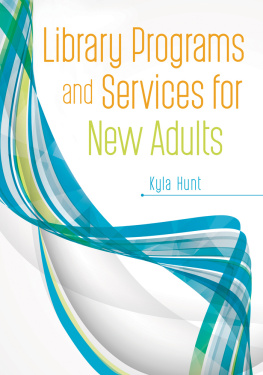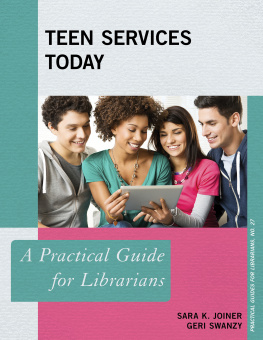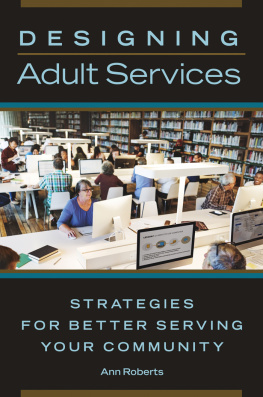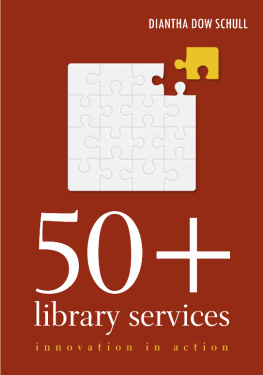LIBRARY PROGRAMS
AND SERVICES FOR
NEW ADULTS
LIBRARY PROGRAMS
AND SERVICES FOR
NEW ADULTS
KYLA HUNT

Copyright 2017 Kyla Hunt
All rights reserved. No part of this publication may be reproduced, stored in a retrieval system, or transmitted, in any form or by any means, electronic, mechanical, photocopying, recording, or otherwise, except for the inclusion of brief quotations in a review, without prior permission in writing from the publisher.
Library of Congress Cataloging-in-Publication Data
Names: Hunt, Kyla, author.
Title: Library programs and services for new adults / Kyla Hunt.
Description: Santa Barbara, California : Libraries Unlimited, [2017] |
Includes bibliographical references and index.
Identifiers: LCCN 2017043511 (print) | LCCN 2017020277 (ebook) |
ISBN 9781440854187 (ebook) | ISBN 9781440854170 (paperback : acid-free paper)
Subjects: LCSH: Adult services in public librariesUnited States.
Classification: LCC Z711.92.A32 (print) | LCC Z711.92.A32 H86 2017 (ebook) |
DDC 025.5/2774dc23
LC record available at https://lccn.loc.gov/2017043511
ISBN: 978-1-4408-5417-0 (print)
978-1-4408-5418-7 (ebook)
21 20 19 18 17 1 2 3 4 5
This book is also available as an eBook.
Libraries Unlimited
An Imprint of ABC-CLIO, LLC
ABC-CLIO, LLC
130 Cremona Drive, P.O. Box 1911
Santa Barbara, California 93116-1911
www.abc-clio.com
This book is printed on acid-free paper 
Manufactured in the United States of America
This book is dedicated to my daughter, Amelia,
the bravest girl I know.
CONTENTS
INTRODUCTION
Heres a fun activity. Take about two minutes out of your day and fill out the following worksheet:
Which of these five life experiences have you completed?
Completing school
Moving away from home
Being financially independent
Getting a job related to your career
Marrying or having a long-term partner
Having or adopting a child
If you have yet to complete 25 of these experiences, you are not yet an adult. Sorry, try next time!
While this activity may seem reminiscent of an online quiz, this is intentional. Versions of these milestones have been included in a variety of online articles, including on The Nest at: https://www.thenest.com/content/all-grown-up-have-you-completed-the-5-milestones-of-adulthood (Barone 2016). Those sites speak to an uncertainty that lies within many of us. Ask yourself: Have you completed the list yet? Have you completed any of the items? If not (and if you are 1829, it is likely that you have not), you could be termed a new adult, and are therefore the subject of this book!
The germ for this book came from my own experiences during and after high school. My high school experience was very structured, and, like many teenagers, expectations for my behavior were clearly laid out by school and family. My daily routine was set by the school day: classes, lunch, band class, free period, marching band practice. My after-school routine was similarly set by my family structure: homework, family dinner, bassoon practice, reading, television, bed. This structure loosened over the summer and on the weekends, providing further freedom to spend time at friends houses, at coffee shops, at movies, or at concerts, but these plans were generally negated if I had other familial or school obligations. Even my religious activities were largely driven by familial expectations, influencing not only my schedule but also my belief structure.
Once I started college (pursuing an oh-so-practical degree in English at the University of Texas at Austin), this structure began to erode. Of course my schedule was still largely centered around school, but unlike high school, I could decide what classes I wanted to take, what path I wanted to follow, when I wanted to wake up, and even if I was going to go to class. There was no law (real or implied) that said I had to attend school daily. I may in the end have disappointed my parents and ended up in a much different career, but if I had so chosen, I could have decided to sleep in instead of going to that 8:00 class.
In both of those experiences, there was room for self-reflection and exploration, but the area explored was different for each. In my teenage years, my outward identity was largely defined; all of my exploration centered on my internal self, and what my personality was in terms of my family and peers. Any rebellion therefore happened in terms of my social personality.
In my late teens and twenties, my personality felt largely established. It was how I expressed that personality and selfhood to the world that was left open for exploration. How long was I going to go to school? How was I going to make money? What type of career did I want to enter? Who did I want to date? Did I want to get married? Did I want kids? How much money should I spend on an apartment? All of those questions, big and small, created waves of uncertainty, learning, and experimentation that only started to calm toward my late twenties. Even now, one of those waves will come over the horizon and I will need to make another major life decision. The difference was, when I was in my early twenties, those waves were constant: at once exciting and somewhat nauseating.
If I could go back and visit my new adult self, I would give her a lot of advice. I would tell her not to get those high-interest credit cards. I would tell her not to sweat the unfruitful job search that I went through shortly after graduation (at least too much). I would tell her to look up more helpful information for determining her future, and spend less time worrying about what bad things might happen. I would tell her to visit a library.
It is those waves of uncertainty that the library can often assist in navigating: new adults have questions, and libraries have answers. It was only after I entered library school and started on my path to becoming a librarian that I realized that. How did it happen? How did a somewhat bookish girl miss the fact that the library held the information that could help me figure out how to be an adult?
The problem is twofold. First, new adults do not tend to seek out the library for answers. Stereotypically, libraries are not where they want to hang out. Their lives are exceptionally busy, and they are flush with the freedom of self-centeredness.
Second, the library does not often think of this group when creating programming, determining layout, or developing outreach. This is true with public libraries, which are so focused on children, teenagers, and older adults. The reasons are obvious: children and teenagers are directed to come to the libraries by their parents, and older adults see the library as a social outreach and place to economically find materials to read and view.
Academic libraries serve new adults, but their focus is often very different. Those libraries are developed with college students academic success in mind. The issues inherent in becoming adultsbecoming financially stable, finding careers, finding partners, finding identityare usually secondary if they exist at all.
The purpose of this book is to attend to both issues. It is, of course, ideal when new adults seek out the library as a source of information and resources. It is vital, however, to remember that that goes two ways: just as libraries want new adults to visit libraries, libraries must make the effort to provide the programs and resources that new adults truly need to learn how to adult.
Next page










